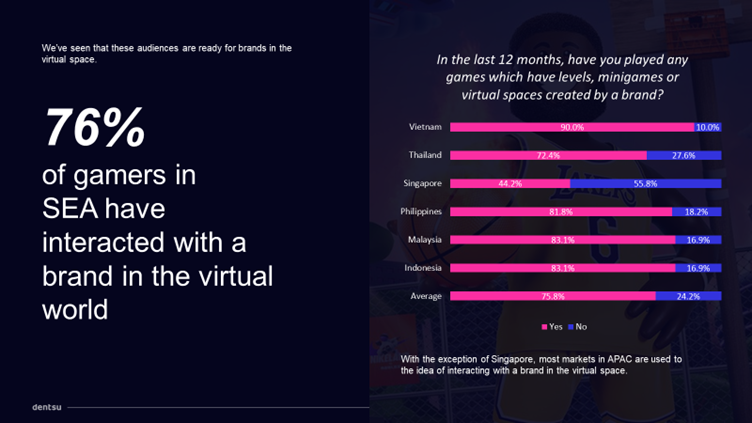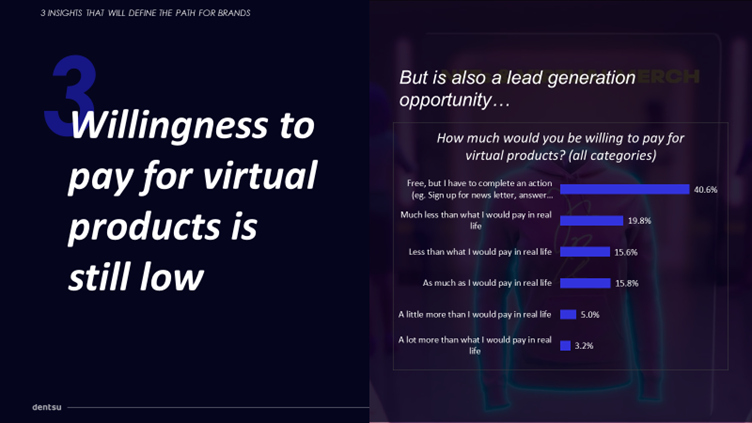While awareness and interest in the metaverse is high, dentsu’s Robin Lau says brands not only need to work harder to stand out; they also need to build their approach around their audience both within and outside the virtual space.
With words like “metaverse” and “NFT” on everyone’s lips, C-suites, brand managers and marketers everywhere are still trying to figure out what it means for their brand to be in the metaverse. And with some of the biggest brands experiencing difficulty in justifying ROI from their “first mover” forays, accompanied with volatility of the blockchain space, whether the risk justifies the reward is still a mystery.
Adding to this confusion and uncertainty is the daily appearance of metaverse and crypto-related news in both mass and business media, in particular placing heavy emphasis on virtual world platforms and their vision for what the future of our virtual lives could look like.
Customer centricity is the key
With a fresh “shiny new thing” dominating headlines every week, it’s very easy for brands to focus heavily on “what” to build or launch in the metaverse, and in turn lose sight of “who” they are doing it for and more importantly “why” they are doing it.
However, like all other marketing best practice, customer centricity is the starting point for brands to define the value they provide in the metaverse. In defining how your brand creates and brings value to your customers in the virtual space, building a strong understanding of not only the customer but their attitudes towards and relationships with virtual spaces is crucial to strategically shaping your business around the digital consumer of tomorrow.
This does not necessarily mean putting your brand in the virtual space or creating brand NFTs. Brands have also started to bring virtual elements out of the metaverse and into the more traditional aspects of their business, such as customer service and even to make their brand more relatable. Even homegrown brands such as CapitaLand Malls have started collaborating with virtual influencers to represent the brand as part of their in-mall events.
Gamers as the early majority
However, with the concept of the metaverse still in its infancy and many virtual world platforms still in their early days, much of the existing metaverse audience are still innovators and early adopters, a very niche group of enthusiasts who are highly motivated to be among the first in the adoption of next-gen technologies – hardly a fair representation of the mass majority. And with no viable mass segment to examine, understanding the digital audience of the future becomes a challenge.
In deconstructing and defining the profile of the metaverse audience, we’ve discovered that the gaming audience, an already mature and widely studied segment of digital consumers, bears many similarities and common traits with the metaverse audience, and ultimately, with further probing, would reveal early insights to how a mass majority audience would approach the metaverse.
- Shared demographics – Millennials and Gen Z. The majority of the world’s gamers falling between these two demographics, and they play the most hours per week and are most willing to make gaming-related purchases. They have been widely recognised as the generation that will pioneer life in the metaverse through the adoption of metaverse technologies.
Millennials who will be the grown-ups with expendable income and digital know-how, and Gen Z who will essentially grow up together with these new technologies as their norm.
- Virtual lives – While there are many genres of games and playstyles that follow, gamers are essentially one of the few audience groups who are already familiar with the idea of living virtual lives. They have not only had exposure to controlling a virtual body/avatar through a digital environment but have also explored the concept of virtual identities as a form of self-representation. Beyond merely existing and interacting with others, they are also familiar with the idea of commerce, payments, currency and carrying out activities in a virtual world (working, tasks, missions, puzzles, relationships and storytelling).
Across APAC, our research has uncovered that 76% of gamers have interacted with a brand in the virtual world and that while interest varies from market to market, audiences have high expectations from brands in the virtual space. They also expect that these brand experiences are unified both virtually and in real life.

Metaverse behaviours
And while we not only analyse the gaming audience, in terms of gamer behaviour and digital lifestyle data through our Consumer Connected Survey database, building data points around metaverse readiness means putting a focus on evergreen metaverse behaviours, including signals such as interest in virtual ownership, desire for brands in the virtual space and expectations of affordability.
When it comes to brands, we’ve uncovered three key insights that will define the path for brands:
1. No significant distinction between brands and other players
Within decentralised spaces or virtual spaces where players can mint items or build environments, there is no significant difference between a brand and other players. This goes for levels and environments, free and paid items and, of course all things being equal, like quality, price, attractiveness etc.
For brands, entering the virtual space means they are now not only competing with other brands but also the players and creators within the platform where, at any point, something more interesting and attractive can emerge from the community, and limited choices in in-world ad capabilities (for now), even among the most established platforms. This means that brands need to prioritise significant marketing efforts in real life to create awareness for their activities in the virtual space.
Where we’ve seen success in this area is when brands create synergy between their offline and social media efforts with their metaverse activities, essentially thinking of the virtual world as an extension of their campaigns.
For example, Tiger Beer created the first ever Virtual Street Food Festival as part of their ongoing hyper local street food campaign in Malaysia. Users explored a virtual food fest and had their favourite local cuisine delivered right to their doorstep, thus blending an online virtual experience with a real-world outcome and ultimately driving tangible results.

2. Brands that are easily accessible in real life are most desirable
When we surveyed the audience on their interest in different categories of products along with level of ownership in real life, it was found that brands which are easily accessible in real life are more attractive than high-aspiration brands or products that do not exist in real life.
While the unaided data essentially indicates that being a high-touch front-of-mind brand could translate to desire for the virtual versions of those products, we cannot ignore (qualitatively speaking) the fact that many of the brands across all of these segments have, in recent years, made significant strides in building a cult following for their brands and venturing into the spaces outside their core business (such as gaming, entertainment and music), essentially building some of the biggest, broadest and most diverse fanbases.
Highly accessible brands such as McDonald’s have in the past seen massive success in spaces such as fashion, merchandising, gaming, e-sports and entertainment IP collaborations, and in turn also seeing similar success as one of the first brands within their segment to launch in the NFT space.
In contrast to this, we’ve seen numerous high-profile luxury brands, such as Gucci, Louis Vuitton and Balenciaga, building their own take on youth culture around their brand and most notably generating some of the highest bidding prices for their virtual items. And while their forays into the metaverse are highly prevalent in headlines, virtual ownership of these brands is still largely as niche and exclusive as their real-life counterparts.

3. Willingness to pay for virtual products still low but is also a major marketing opportunity
And while stories of million-dollar virtual outfits and NFTs dominate our headlines on an almost weekly basis, the vast majority are still hesitant to pay even real-life equivalent prices for virtual items.
When surveyed, the general majority would expect to get these items for free, if not pay less than what they would in real life, indicating that while virtual goods can be attractive and audiences know that there they have intrinsic value, they do not perceive it to be worth the high price as portrayed in the mass media.
However, they are very willing to complete an action in exchange for these items, such as signing up for a newsletter, answering a survey or following a brand on social. Brands have leveraged this desire for NFTs as the new freebie in campaigns, getting audiences to engage in more meaningful ways, such as driving awareness for a good cause or engaging with the local arts community, essentially as extensions of their campaigns in an environment where real life events can be challenging and audiences are increasingly living their lives in the virtual space.

With the future of the metaverse heavily shaped by today’s gaming habits, ultimately our biggest takeaway is that while awareness and interest in the metaverse is high, not only do brands need to work harder to stand out, but they also need to build their approach around their audience both within and outside the virtual space.

